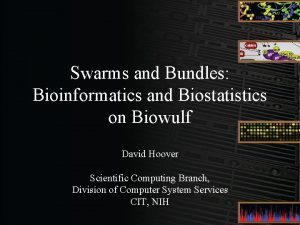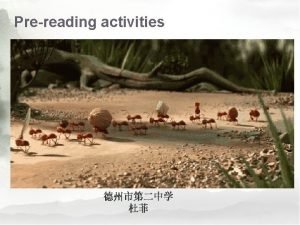Terra Swarm Overview of The Terra Swarm Research

- Slides: 1

Terra. Swarm Overview of The Terra. Swarm Research Center http: //terraswarm. org/ Edward A. Lee (Director), Jan Rabaey (Associate Director), UC Berkeley The Mission The Problem Space “The swarm, ” in this project, refers to the vast collection of networked sensors and actuators being installed in our connected world. The project is pursuing a vision of these sensors and actuators as an extension of the cloud, an extension from the infosphere into the physical world. It gives the cloud eyes, ears, hands, and feet, enabling services that are directly embedded in the physical world rather than just the cyber world. While the pervasive integration of smart, networked sensors and actuators into our connected world has huge potential to address societal problems and to improve our quality of life, it comes with enormous technical challenges and both technical and non-technical risks. This project is tackling these challenges and risks, primarily through the creation of an open and universal platform to enable the simple, reliable, and secure deployment of a multiplicity of distributed sense and control applications. We call these swarm applications “swarmlets. ” The platform supporting the development of swarmlets is a systems architecture providing access control, resource brokerage, and service-level contracts. Making the platform open and well-defined promises to unleash the creativity of millions of swarmlet developers, just as smart-phone platforms opened the door to millions of app developers. Infrastructural core Mobile Access & Relay The Swarm The problems being solved: 1. Unfulfilled potential of networked sensors and actuators. 2. Stovepiped designs of closed systems. 3. Brittle systems, where failure of a single networked component prevents a service from being delivered. 4. Fragmented standards, obstacles to interoperability of components. 5. Missing platforms, which force application developers into lowlevel, hardware-specific application design. 6. Unadaptable systems that cannot adapt to a changing environment of sensing, actuation, networking, and computing resources. 7. Energy inefficient systems, where components must be tethered to power sources. 8. Unevolvable systems that do not gracefully take advantage of new technologies and services. Deliverables/Products: Smart Cities – An integrated challenge problem: developing Terra. Swarm technologies that will provide innovative, city-scale capabilities both in day -to-day operation and in times of crisis. Platform Architectures and Operating Systems – A hierarchical and compositional system architecture, supported by a distributed, loosely coupled executive called the "Swarm. OS. ” The Team The Cloud June 6, 2021 Services and Cloud Interaction – Technologies for scalable, adaptive composition of heterogeneous services that combine handheld communication, sensing, networked actuators, computing devices, wireless and wired networks, and cloud-based computing. Methodologies, Models, and Tools – Formal, rigorous, and automated design techniques, tools, algorithms, and flows that become services that can be recruited online for dynamic adaptation of Terra. Swarm services. Applications of the Technology • • • • Smart Buildings and Cities Energy efficiency Energy production/distribution Situational awareness Interactive spaces Efficient transportation Location-based services Warfighting Health care Disabled and elderly Brain enhancement Manufacturing and Agriculture Security Quality of Life Applications Swarm-OS Resources Sponsored by the Terra. Swarm Research Center, one of six centers administered by the STARnet phase of the Focus Center Research Program (FCRP) a Semiconductor Research Corporation program sponsored by MARCO and DARPA.

